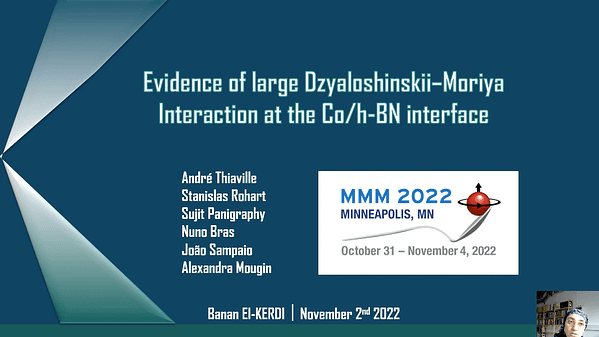Would you like to see your presentation here, made available to a global audience of researchers?
Add your own presentation or have us affordably record your next conference.
Under a longitudinal applied magnetic field, microwires increase/decrease length depending on the magnetostriction sign, where the magnetostrictive elongation is due to magnetization rotational processes as well known in classical magnetism. In amorphous alloys, magnetostriction is usually evaluated making use of inverse magnetoelastic effects (e.g., SAMR method) that sometimes is not fully reliable (e.g., for positive magnetostriction) 1.
This study in magnetostrictive and non-magnetostrictive amorphous microwires introduces two original aspects: i) Direct magnetostrictive elongation measurements as a function of applied field and tensile stress; and ii) Re-interpretation of the magnetization mechanism by comparing magnetostrictive elongation and magnetization curve.
A home-made setup with suitable induction/pickup coils, a mechanical system to apply stress and a high-accuracy LVDT position sensor has been used to measure magnetization, M, and magnetostrictive elongation, δl/l,2 in two amorphous microwire families: i) In-water-quenched (~145 μm diameter) highly magnetostrictive FeSiB, and vanishing positive/negative magnetostriction (CoFe)SiB microwires; and ii) Glass-coated FeSiBC microwire (20 μm diameter).
The figures show high-sensitivity (down to δl/l=10-8) representative data of δl/l vs. M/Mmax and H where the applied stress increases/reduces the elongation for negative/positive magnetostriction. Quantitative information on the rotational magnetization for low/high field regions is obtained: note in Fig. 1 the different elongation slopes for low (domain wall) and high (rotational) magnetization processes. It is also noticeable the magnetostrictive effect in Fig. 2 inset during domain wall motion in the tiny wire due to a helical magnetization component. This method to properly quantify the magnetostrictive elongation allows for a new magnetization/magnetostrictive analysis as required in mechanical sensor devices.
References:
1 C. Gómez-Polo and M. Vazquez, J. Magn. Magn. Mater. 118, 86 (1993); K. Chichay et al., J. Appl. Phys. 116, 173904 (2014).
2 J. Moya et al., J. Magn. Magn. Mater. 476, 248 (2019).

Fig.1 Magnetostrictive elongation (δl/l) vs. Magnetization (M/Mmax) for a range of applied stresses (σ) in water quenched microwires.

Fig. 2 Magnetostrictive elongation (dl/l) vs. applied Field (H) in FeSiB glass-coated microwire. The inset shows the low-field magnetization and elongation loops.
